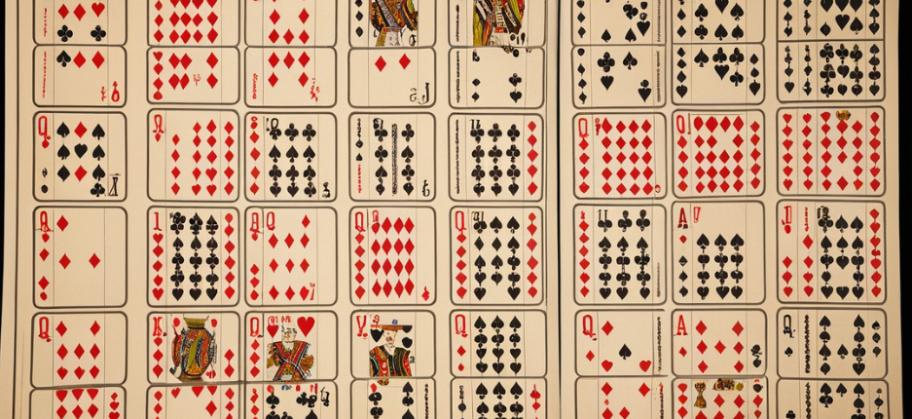Are you tired of constantly losing at the poker table? Do you feel like you’re always second-guessing your decisions and missing out on potential winning hands? If so, then it’s time to level up your game with the poker chart!
In this article, we will explore what a poker chart is and how you can use one to make informed decisions, refine your strategy, and take your game to the next level. So, whether you’re a beginner or an experienced player, a poker chart can be your secret weapon to mastering the game! Let’s dive in to learn more.
What Is A Poker Chart

A Poker chart is a visual representation of important information. This includes hand rankings, starting hands, odds and equities, Pre-flop and Post-Flop scenarios, and more. Players can use the information on the chart to make strategic decisions during a game, including whether to fold, continue playing, or bet more.
Thus, in simple terms, a poker chart acts like a map that can guide you toward making the right decisions by telling you what to do with your cards. By doing so, it maximizes your chances of winning.
That said, there are different types of poker charts, each focusing on a specific aspect of the game. We have explained some of the different types of Poker Charts below:
Poker Hand Rankings Chart

This is the most basic chart and is essential for beginners. It simply shows the order of winning hands in poker, from the strongest (Royal Flush) to the weakest (High Card). You can think of it as a poker cheat sheet that will help you figure out whether your hand is strong enough to win the pot or if you should fold. In this context, you should also note that a standardized hand rankings chart is followed across all variations of poker, which includes Texas Hold’em, Omaha, Seven-Card Stud, and more.
Preflop Starting Hands Charts

These charts guide players on which starting hands they should consider playing. The tips offered by these charts are based on their position at the table (e.g., dealer, early position, late position). Another factor that is taken into consideration is how many players are involved in the pot before the flop (the first betting round in poker variations like Texas Hold’em and Omaha).
For example, a Preflop starting hands chart might recommend raising with pocket Aces in the early position but calling with suited connectors in the late position. However, you should remember that these charts only act as a guide and are not a rigid rulebook. So, in addition to consulting a Preflop starting hands chart, you should adapt your strategy based on table dynamics, opponents’ playing style, and your read on opponents.
Pot Odds Charts
These charts help you determine if calling a bet is mathematically sound based on the ratio between the size of the total pot and the amount you need to call. For example, if the pot is much larger than the amount you need to call, even with a weak hand, calling might be profitable.
In general, the formula used to calculate pot odds is quite simple. You can do it at the poker table if you are good at mental calculation. Here are the steps that you need to follow:
Step 1: Calculate the final pot size if you were to call the bet.
Step 2: Divide the size of the call by the final pot size.
Step 3: Convert the result into a percentage to see how often you need to win for the call to be profitable.
Here is an example: Suppose the total pot is $200, and the bet is $50; your pot odds are:
50/200 X 100 = 25%.
This means that you need to win more than 25% of the time for your call to be profitable.
Pot Odds Charts typically list common scenarios and their corresponding pot odds. This makes it easier for players to make quick decisions without having to calculate odds in the heat of the moment. They are not very common as a standalone tool in poker but are often used together with other poker charts like post-flop charts and equity charts.
Outs and Equity Charts

These advanced charts help you calculate the probability of improving your hand to a winning one after the flop, turn (fourth community card), or river (fifth community card) are revealed. They consider the number of outs (cards that can improve your hand) and your hand equity (the chance of winning based on your current hand and the community cards).
Push/Fold Charts (Shove Charts)

These are used in situations where you either go all-in (shove) or fold your hand. These are typically used in tournament situations where considerations like chip stack size and potential blinds come into play.
Benefits of Poker Chart: Why is it a handy tool for beginners?

Here are some of the key benefits of using poker charts:
Improved Hand Selection (Especially for Beginners):
For new players, poker charts offer a clear starting point for selecting strong hands to play pre-flop. By following the recommendations for your position at the table, you can avoid playing weak hands that are likely to lose money.
Stronger Foundation in Pot Odds and Outs:
Many charts incorporate pot odds and outs calculations into their recommendations. This helps beginners grasp these important concepts and understand how they influence decision-making.
Structured Approach to Post-Flop Play:
While pre-flop charts are more common, some advanced charts offer guidance on navigating post-flop situations. They consider the texture of the board (connected cards, suited cards, etc.) and your hand strength to suggest actions like calling, raising, or folding.
Faster Decision-Making:
Charts can help you make quicker decisions, especially during pre-flop play. By having a reference for strong hands based on your position, you can avoid time-consuming analysis paralysis. This is particularly beneficial in fast-paced online poker games.
Level Up Your Game:
Charts aren’t just for beginners. Even experienced players can use them as a reference point, especially when encountering unfamiliar situations or playing against unknown opponents. Charts can help refine your strategy and identify potential leaks in your game.
Understanding the components of a poker chart

Before we delve deeper into the benefits of using a poker chart, let’s take a moment to understand its components. A typical poker chart consists of a grid that displays the different starting hands you can have in poker.
The hands are categorized into different groups, ranging from premium hands to speculative hands. Each hand group is assigned a specific color code or label to make it easier to identify.
Additionally, the chart may also include additional information, such as the positions from which you should play certain hands. By familiarizing yourself with the components of a poker chart, you’ll be better equipped to navigate through the game and make informed decisions.
Here are some of the components of the Poker Chart:
Game Information
This will usually specify the variant of poker the chart applies to (e.g., Texas Hold’em, Omaha).
Player Position
Some charts, like preflop starting hand charts, will consider your position at the table (dealer, early position, late position), as this can influence your starting hand selection.
Number of Players Involved
Preflop charts might also take into account the number of players in the pot before the flop, as this affects the likelihood of someone having a strong hand.
Action
Some charts might indicate whether the chart is for opening hands (preflop), calling a bet on the flop/turn/river, or pushing all in (shoving).
Hand Rankings
Basic hand ranking charts simply list out poker hands in descending order of strength.
Hand Combinations
Preflop starting hand charts will show specific card combinations (e.g., A-A, K-Q) and recommend playing them based on the factors mentioned above.
Pot Odds
Pot odd charts might display ratios or a color-coded system to indicate whether calling a bet is mathematically sound based on the pot size and amount you need to call.
Outs and Equity
These charts might show the number of outs (cards that improve your hand) or your hand equity (chance of winning) based on your hand and the community cards revealed.
Stack Sizes (Shove Charts)
Push/Fold Charts often consider your chip stack size relative to the blinds (mandatory bets) when recommending shoving all-in or folding.
How To Use A Poker Chart To Decide A Game Strategy

Poker charts can be a helpful tool for beginners and experienced players alike, but it’s important to understand how to use them effectively within your overall strategy.
Using a poker chart to make pre-flop decisions
The pre-flop stage of a poker hand is one of the most critical moments where a poker chart can be a game-changer. It’s during this stage that you decide whether to play your hand, raise, call, or fold.
By consulting a poker chart, you can quickly determine the optimal range of hands to play based on your position at the table and the actions of your opponents. For example, if you’re in an early position, the chart may advise you to play only premium hands such as pocket aces or kings.
However, if you’re in a late position and no one has raised before you, the chart may recommend playing a wider range of hands. By following the guidelines on the poker chart, you can make more confident decisions and increase your chances of success.
Post-flop strategies with the help of a poker chart

Once the community cards are revealed, the post-flop stage begins, and this is where a poker chart becomes even more valuable. Post-flop strategies can be complex and require careful analysis of the board, your opponent’s actions, and their likely hand ranges.
By referring to a poker chart, you can quickly assess the strength of your hand relative to the board and make informed decisions. The chart may recommend continuation betting with certain hands, bluffing in specific situations, or folding if the board is unfavorable. So using a poker chart to decide your post-flop strategy will help you to increase your chances of winning.
Analyzing opponent’s ranges with a poker chart

One of the most powerful aspects of using a poker chart is its ability to help you analyze your opponents’ hand ranges. By observing their actions and comparing them to the recommendations on the chart, you can narrow down the possible hands they may be holding.
This information is invaluable in making accurate decisions and gaining an edge over your opponents. For example, if your opponent raises pre-flop from an early position, the poker chart may suggest that they have a strong hand.
Armed with this knowledge, you can adjust your strategy accordingly and avoid getting trapped in a losing battle. By combining your observation skills with the insights provided by the poker chart, you can become a formidable opponent at the table.
Adjusting your strategy based on your position using a poker chart

Your position at the poker table plays a crucial role in determining your strategy, and a poker chart can help you make the most of it. The chart will provide you with recommendations on which hands to play from each position. For this, the chart takes into account factors such as the number of players at the table and the likelihood of facing raises.
For example, if you’re in an early position, the chart may advise you to play only premium hands to avoid potential traps. However, if you’re in a late position, the chart may recommend playing a wider range of hands since you have more information about your opponents’ actions. By adjusting your strategy based on your position using a poker chart, you can exploit the advantages of each position and maximize your chances of success.
Final Thoughts
To sum up, a poker chart is an indispensable tool for any serious poker player looking to improve their game. From pre-flop decisions to post-flop strategies, analyzing opponent’s ranges, and adjusting your strategy based on your position, a poker chart can completely
change your gameplay for the better. So, don’t waste any more time guessing your way through the game. Get your hands on a poker chart today, and you will be able to master the game with a winning strategy in no time!
Read Also:







